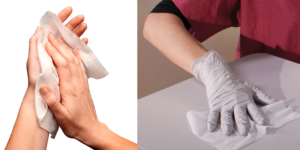Interventional Care


We notice that you are visiting us from . This site only services US-based visitors. Would you like to visit the site that is appropriate for your location?

In the midst of the flu season storm, we have become hyper vigilant about alerts on new and multiple outbreaks, and often, with good reason. The final months of 2017 showed an increase in influenza activity and as 2018 begins, the trend continues upward.[1]
Although influenza and the flu season are major threats, in the healthcare arena they are not the only outbreaks of concern.
The “Big” Ones:
Hospitals and their healthcare affiliates (facilities) can serve as reservoirs for the lightning fast transmission of debilitating infections and the potential for different types of outbreaks. In this setting where comorbidities and immunocompromised patients are the norm, microorganisms may take on a highly negative impact. As with many severe outbreak situations, the onset is rapid and it can spread like an out-of-control wildfire, wreaking havoc on normal hospital routines and protocols, plus adding stress to both healthcare workers and patients.
Although each outbreak must be investigated for its root cause, there are common routine methods that should be implemented to help mitigate the outbreak, and help prevent future crisis situations.
Evidence suggests that the transmission of many healthcare acquired pathogens (HAPs) is related to contamination of near-patient surfaces and equipment. Hospitals are encouraged to develop programs to optimize the thoroughness of high-touch surface cleaning as part of terminal room cleaning at the time of discharge or transfer of patients.[5] Assessment of each situation will identify the need for standard and contact precautions, as well as isolation precautions when warranted. Multiple guidelines are also readily available with specific recommendations and checklists to help standardize the protocols and assure that no steps are forgotten. They address environmental cleaning and disinfection plus hand hygiene as imperative pieces to the puzzle—both simple, but often overlooked as part of the standardized checklist for infection prevention.
Because of the potential for hand contamination even during brief encounters, Infection Preventionists (IPs) should stress that improving adherence with hand hygiene may have an important overall impact on disease transmission.[6] Running in to a patient’s room to answer their call bell and turn it off might not seem as though it requires a high priority need for hand hygiene and disinfection of the object, but think of the other potentially contaminated hands that have touched that object and then go on to touch a patient. It’s an “a-ha” moment to highlight the need for including the basics of hand hygiene and environmental disinfection as steps within overall protocols.
Easy access to hand-hygiene supplies, whether sink, soap, medicated detergent, or alcohol-based hand-rub solution, is essential for optimal adherence to hand-hygiene recommendations. The time required for nurses to leave a patient’s bedside, go to a sink, and wash and dry their hands before attending the next patient can be a deterrent to frequent handwashing or hand antisepsis.[7] Necessary supplies should be readily available to limit any excuse for missing this crucial step in the infection prevention process.
Some formulations of alcohol-based wipes with at least 65% alcohol are now comparable to alcohols delivered by other dispensing methods. Alcohol-containing hand wipes offer a convenient option for bed-bound patients, first responders, and others who cannot easily get to sinks or wall-mounted dispensers.[8]
Proper disinfection of high touch surfaces should be done with an appropriate EPA-registered hospital grade disinfectant and the checklist should identify not only the objects to be cleaned and disinfected, but also the frequency in which it should be cleaned/disinfected, and the staff member responsible for handling. If ownership is not identified, it can be easily overlooked. The process will be successful when the simplest of details are given as much focus as other major mitigating factors. Our vigilance should not just be heightened when the crisis occurs. We need to develop habits and routines that are consistent on a daily basis and part of the norm to help with prevention and stop the outbreak before it occurs.
[1] CDC Fluview. Weekly U.S. Influenza Surveillance Report. 2017-2018 Influenza Season Week 1 ending Jan 6, 2018
[2] CDC.gov. Healthcare Associated Infections, Clostridium Difficile Infection, March, 2011
[3] Rhinehart, Emily; ,Scott Walker, Denise Murphy, Karen O’Reilly, and Patty Leeman, Frequency of outbreak investigations in U.S. hospitals: Results of a national survey of infection preventionists,” American Journal of Infection Control, Volume 40, Issue 1 (February 2012).
[4] Most Common Healthcare-Associated Infections: 25 Bacteria, Viruses Causing HAIs; Beckers Clinical Leadership and Infection Control; May, 2014.
[5] Guh, Alice, MD, MPH1, ,Philip Carling, MD2, Environmental Evaluation Workgroup3 Options for Evaluating Environmental Cleaning, CDC Healthcare Associated Infections, December, 2010.
[6] APIC Implementation Guide; Guide to Preventing Clostridium Difficile Infections; 2013
[7] CDC Morbidity and Mortality Weekly Report, October 25, 2002 / Vol. 51 / No. RR-16
[8] Strategies to Prevent Healthcare-Associated Infections through Hand Hygiene, Society for Healthcare Epidemiology of America, 2014. www.sheaonline.org.